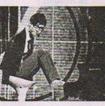根据短文内容及首字母提示,填写所缺单词。Many Chinese leaders are fond of ancient Chinese literature. Xi Jinping, who was b小题1:in June 1953 in Beijing, was a g-九年级英语
题文
| 根据短文内容及首字母提示,填写所缺单词。 Many Chinese leaders are fond of ancient Chinese literature. Xi Jinping, who was b 小题1: in June 1953 in Beijing, was a graduate of Tsinghua University and j 小题2: the CPC in January 1974. When Xi Jinping was elected (选举) China’s president at the National People’s Congress in March last year, he talked about some of his ideas on h 小题3: to run a government. When he spoke, many Chinese people were pleasantly s 小题4: to find that Xi Jinping has good knowledge of Laozi and Daois. “Running a large country is like frying a small fish(治大国如烹小鲜),” he said at the meeting. It’s a quote from Tao Te Ching(《道德经》),a book w 小题5: by Laozi over 1,200 years ago. In fact, it was not the f 小题6: time Xi had quoted Laozi. Xi often referred to (参照) the beliefs of this great thinker when he worked a 小题7: a provincial governor(省长). Xi Jinping is not the o 小题8: leader who is interested in Laozi. Russian Prime Minister Dmitry Medvedev said in an i 小题9: with XinHua News Agency in October 2013, “He who conquers others is strong; he who conquers himself is might(胜人者有力,自胜者强). It was true 2,000 years ago, and it is s 小题10: true in the 21st century.” |
答案
小题1:born 小题2:joined 小题3:how 小题4:surprised 小题5:written 小题6:first 小题7:as 小题8:only 小题9:interview 小题10:still |
试题分析:这篇短文主要介绍了许多中国领导人喜欢中国古代文学。习近平就是其中之一。当他做为一省之长时他就经常引用老子这个伟大的思想家的理念 小题1:出生在1953年6月的习近平就是清华大学的毕业生,故填born 小题2:在1974年1月加入中国共产党。加入组织,故填joined 小题3:在政府怎样运行上他谈到了他的一些想法,根据句意,故填how 小题4:许多人都欣喜的发现习近平具有老道的良好知识,故填surprised 小题5:一本由老子在1200年前写的书,过去分词做后置定语,故填written 小题6:实际上这不是习近平第一次引用老子,故填first 小题7:当他做为一个省长时他就经常引用这个伟大的思想家的理念,故填as 小题8:习近平不是唯一一个对老子感兴趣的领导人,故填only 小题9:俄罗斯总理德米特里?梅德韦杰夫在新华社2013年10月采访中说,故填interview 小题10:两千年前这是真实的,在21世纪,它仍然是真实的,故填still |
据专家权威分析,试题“根据短文内容及首字母提示,填写所缺单词。Many Chinese leaders..”主要考查你对 物主代词,单词、词组 等考点的理解。关于这些考点的“档案”如下:
物主代词单词、词组
考点名称:物主代词
- 物主代词:
表示所有关系的代词叫做物主代词,也叫人称代词的所有格。
物主代词分为形容词性物主代词和名词性物主代词两种。
物主代词有人称和数的变化。第三人称单数的物主代词还有性别的变化。 物主代词的用法:
物主代词既有表示所属的作用又有指代作用,例如:
John had cut his finger; apparently there was a broken glass on his desk.
约翰割破了手指,显而易见,他桌子上有个破碎的玻璃杯。
物主代词有形容词性(my, your等)和名词性(mine, yours等)两种:
形容词性的物主代词属于限定词。
名词性的物主代词在用法上相当于省略了中心名词的 -'s属格结构,例如:
Jack's cap 意为 The cap is Jack's.
His cap 意为 The cap is his.形容词性物主代词用法:
1. 形容词性物主代词相当于形容词,在句中只能用作定语,后面必须跟名词。名词性物主代词常用来避免和前面已提及的名词重复。
相当于【形容词性物主代词+名词】。例如:
Is that yourbike? 那是你的自行车吗?
My pen is quite different from his.
2. 如果名词前用了形容词性物主代词,就不能再用冠词(a, an, the)、指示代词(this, that, these, those)等修饰词了。例如:
这是他的书桌。This is his desk.
3. 与形容词一起修饰名词时,形容词性物主代词要放在形容词的前面。例如:
his English books他的英语书。
their Chinese friends他们的中国朋友。
4. 汉语中经常会出现"我妈妈","你们老师"等这样的语言现象,虽然代词用的是"我"、"你们",但实际意义仍是"我的"、"你们的",
所以在英译时,注意要用形容词性物主代词"my","your"。
例如:你妈妈在家吗?
误:Is you mother at home?
正:Is yourmother at home?
5. it's与its读音相同,he's与his读音相似,但使用时需注意它们的区别(it's和he's分别是it is和he is的缩略形式,但its 和his 却是形容词性物主代词) 。
例如: It's a bird. Its name is Polly. 它是一只鸟。它的名字叫波利。
He's a student. His mother is a teacher. 他是一名学生。他妈妈是一位教师
口诀:
有“名”则"形“,无“名”则“名”。
意思是:后面是名词的话,前面就要用 形容词性物主代词。后面没有名词的话,就用名词性物主代词。名词性物主代词的句法功能:
a. 作主语,例如:
May I use your pen? Yours works better.
我可以用一用你的钢笔吗? 你的比我的好用。
b.作宾语,例如:
I love my motherland as much as you love yours.
我爱我的祖国就像你爱你的祖国一样深。
c.作介词宾语,例如:
You should interpret what I said in my sense of the word, not in yours.
你应当按我所用的词义去解释我说的话,而不能按你自己的意义去解释。
d.作主语补语,例如:
The life I have is yours. It's yours. It's yours. 我的生命属于你,属于你,属于你。
名词性物主代词可以用在介词of的后面,相当于“of+名词所有格”。
口诀
有“名”则"形“,无“名”则“名”。
注:
后面是名词的话,前面就要用 形容词性物主代词。
后面没有名词的话,就用名词性物主代词.形容词性物主代词与名词性物主代词的区别:
一.形容词性物主代词起形容词的作用,用在名词前。
例:
1. This is my book.这是我的书。
2. We love our motherland.我们热爱我们的祖国。
二.名词性物主代词起名词的作用。
例:
1. Look at the two pencils. The red one is yours and the blue one is mine.
看那两支铅笔,红的是你的,蓝的是我的。
2. He likes my pen. He doesn't like hers.
他喜欢我的钢笔。不喜欢她的。
3. 注意:在使用名词性物主代词时,必须有特定的语言环境,也就是要省略的名词。
例:
It's hers.是她的。
(单独使用大家不知是怎么回事,不可以这样用)
There is a book. It's hers.那有本书。是她的。
(先提及,大家才明白)
4. 名词性物主代词=形容词性物主代词+名词
为避免重复使用名词,有时可用“名词性物主代词”来代替“形容词性物主代词+名词”的形式。
例:
My bag is yellow, her bag is red, his bag is blue and your bag is pink.
- 最新内容
- 相关内容
- 网友推荐
- 图文推荐
| [家长教育] 孩子为什么会和父母感情疏离? (2019-07-14) |
| [教师分享] 给远方姐姐的一封信 (2018-11-07) |
| [教师分享] 伸缩门 (2018-11-07) |
| [教师分享] 回家乡 (2018-11-07) |
| [教师分享] 是风味也是人间 (2018-11-07) |
| [教师分享] 一句格言的启示 (2018-11-07) |
| [教师分享] 无规矩不成方圆 (2018-11-07) |
| [教师分享] 第十届全国教育名家论坛有感(二) (2018-11-07) |
| [教师分享] 贪玩的小狗 (2018-11-07) |
| [教师分享] 未命名文章 (2018-11-07) |


![—______ is Jenny.—I’m Gina. Nice to meet you.[ ]A. I’mB. His nameC. I’mD. My name-七年级英语](http://www.00-edu.com/d/file/ks/4/2/wuzhudaici/2019-11-29/small48b153aa794daeb090c5d2505d5cbbac1575042450.png)



